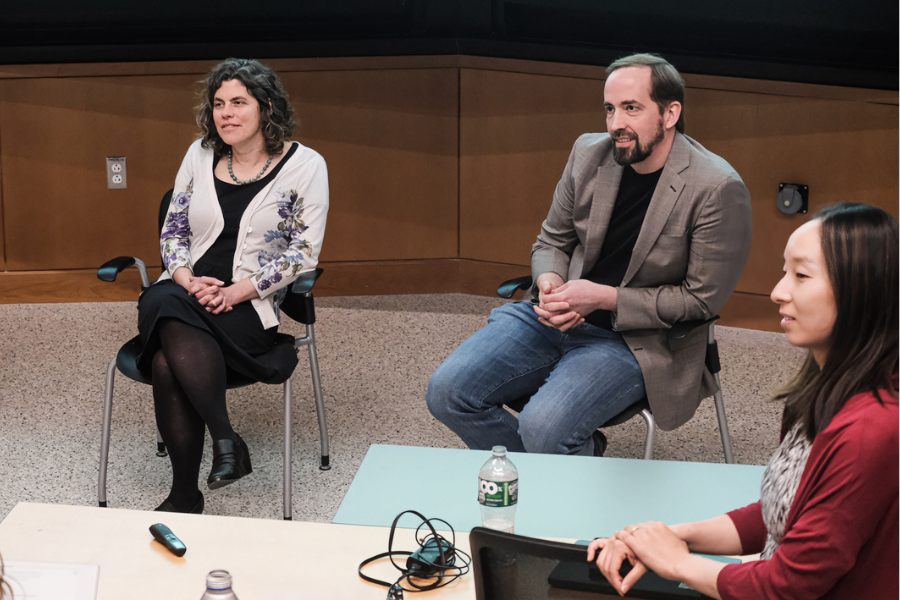News J-WAFS researchers present agricultural projects to MIT alumni
Mary Gehring, Matt Shoulders, and Chris Voigt spoke about using synthetic biology for agriculture at a Tech Reunion event sponsored by J-WAFS.
Carolyn Blais June 7, 2024

80% of the nitrogen in your body came through the Haber-Bosch process, noted Chris Voigt, a professor and head of the Department of Biological Engineering during a Tech Reunion event hosted by J-WAFS. He explained that Haber-Bosch is a highly energy-intensive manufacturing process that enables mass production of synthetic nitrogen fertilizer. While it has contributed significantly to agricultural productivity over the past century, Haber-Bosch is a “dirty, difficult process,” Voigt says, that is alone responsible for 2% of the world’s total energy consumption. It also produces significant greenhouse gas emissions (GHGs). For years, Voigt has been working on engineering biological processes that are capable of making atmospheric nitrogen available to crops. In his talk titled: “Engineered bacteria for environmental release: agricultural and bioremediation solutions,” he explained the technology being commercialized by the company spun out of his lab, Pivot Bio. The company’s product is an engineered microbe that can fix atmospheric nitrogen and colonizes the roots of corn crops. It saves farmers about 20% of synthetic fertilizer use while generating 97% less GHGs, and is now applied to approximately 6% of the U.S. corn crop.
Voigt’s talk was part of a J-WAFS hosted seminar titled “Tomorrow’s Harvest: Synthetic Biology for Agriculture.” The event featured three MIT faculty members with J-WAFS projects related to agricultural challenges. Over the past ten years, J-WAFS funding has helped dramatically increase MIT research on a variety of food and agriculture needs, including challenges to which MIT expertise in bioengineering is increasingly being applied. In addition to Voigt, two other J-WAFS professors presented their research addressing different challenges in crop plant biology: Professor Mary Gehring of the Biology Department and the Whitehead Institute for Biomedical Research, and Professor Matt Shoulders of the Department of Chemistry.
Longzhen Han, J-WAFS’ director of external relations, introduced J-WAFS to the alumni audience, noting its commitment to water and food research at MIT. Han also highlighted J-WAFS’ many research accomplishments, as well as J-WAFS-supported spinouts in AgTech, and collaborations through the J-WAFS-led Food and Climate Systems Transformation (FACT) Alliance.
Professor Shoulders spoke about his project called Enhanced Photosynthesis in Crops, or EPiC. In his talk, Shoulders explained that we face an agricultural demand gap. “There is a huge mismatch between yield and demand,” he said. This is due to a growing population and a warming climate that are both impacting many aspects of agriculture globally. As a result, Shoulders says we need practical approaches. One approach his lab is taking, along with several collaborators both at MIT and external partner institutions, is to try to enhance an inefficient aspect of photosynthesis—the enzyme RuBisCO. This enzyme converts carbon dioxide from the atmosphere into sugars that the plant needs to grow. The problem is, RuBisCO is slow acting. It can process about three reactions per second. Other enzymes can carry out thousands of reactions per second, Shoulders says. What’s more, RuBisCO often reacts with oxygen instead of carbon dioxide, making the process metabolically wasteful for the plant. With support from J-WAFS’ first Grand Challenge grant, Shoulders and his team are working to evolve and design better crop RuBisCO to make the enzyme both faster and more specific. While this may seem like a tall order, considering other researchers claim Rubisco may be trapped in its evolutionary space, Shoulders says that even minor improvements to RuBisCO could benefit crop yields and transform agriculture.
Professor Gehring works alongside Shoulders on the EPiC project, and she is also leading a J-WAFS seed grant project called, “Enhancing genetic diversity to improve crop breeding.” She echoed Shoulders sentiment that a climate-altered world is making food security a major issue. She added that the global food supply is homogenized, with 90% of the calories we eat coming from only 50 crops, many of which are threatened by climate change. As a result, there is a need to expand the crop species we consume by growing underutilized crops. In her J-WAFS project, Gehring is researching one such crop—the pigeon pea. While consumed widely in Africa, Asia, and Latin America, the pigeon pea is less prevalent in other parts of the world. Gehring explained that the pigeon pea is a perennial legume that shows resilience to climate stresses like drought. The downside to the pigeon pea is its lack of genetic diversity. Adapting to climate change, Gehring says, requires breeding desired traits into numerous plant species economically and without substantial regulatory hurdles. Therefore, the Gehring lab is researching how to accelerate the production of genetic diversity within the pigeon pea crop through mutagenesis, that is, altering the genetic information of the plant. They are doing this through an inexpensive chemotherapy drug to create structural variation and new traits. The goal is to enhance food security by evolving crops that are potentially more adapted to changes in global climate.
Some of the attending alumni came from an era when MIT had a Department of Food and Nutrition Science. Although the department was terminated in the mid-1980s, research on food and agriculture at MIT has been experiencing a resurgence in recent years across a variety of departments in the Schools of Science, Engineering, and elsewhere. As exemplified by the three talks hosted by J-WAFS, MIT still has much to contribute when it comes to protecting our food supply in the face of climate change challenges and reducing agriculture’s energy and environmental footprint.